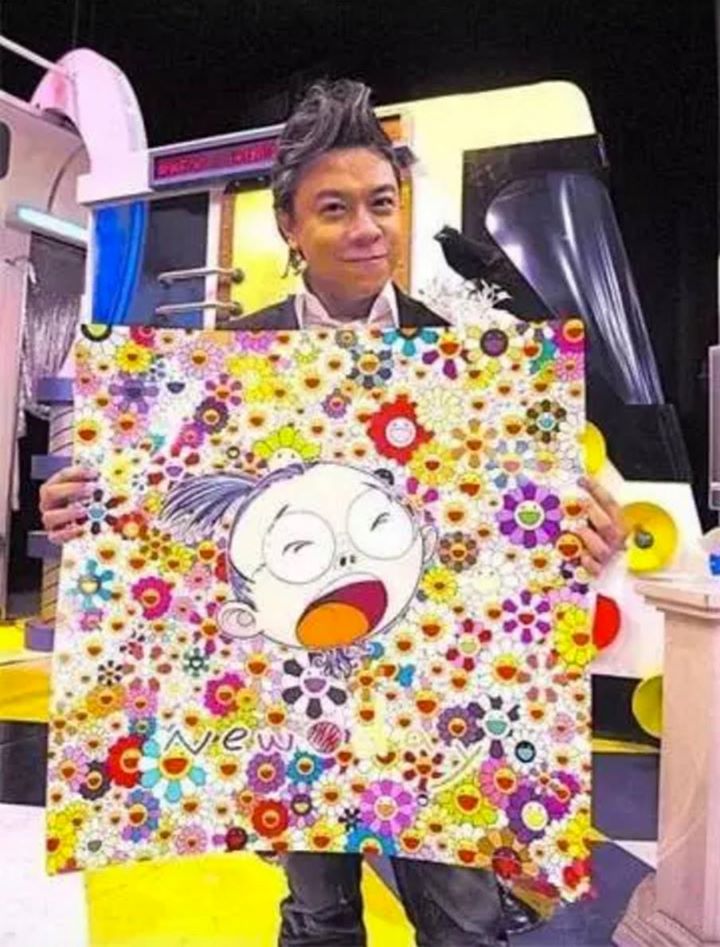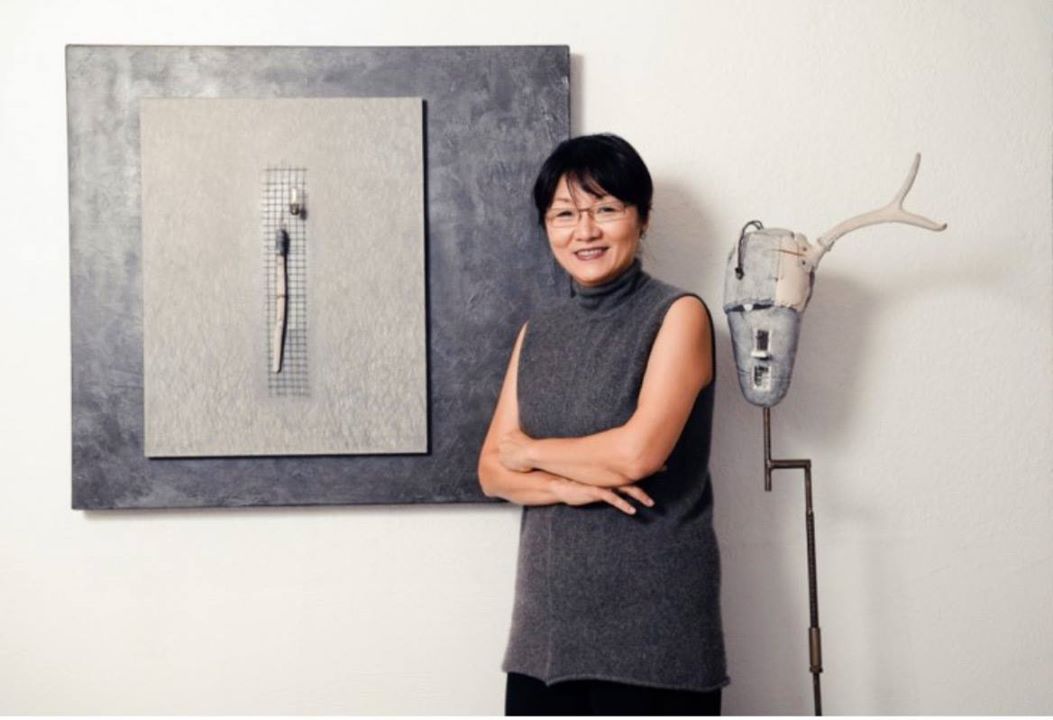Kevin Tsai (蔡康永), is a famous writer and television host in Taiwan. Kevin was born to a wealthy family and his father was a well known lawyer and his family was briefly in the shipping business. Kevin went to private schools for his pre – bachelor education.
In the Asian showbiz circle, Kevin Tsai is a predecessor with a prolific career. However little is known about his vast art collection and knowledge in the field of art collecting, as he has always been a very private person.

For Kevin, he appreciates the freedom and rebellion showcased in art. Kevin was 15 years old when he bought his first painting. His father instructed him one day to visit a friend’s art exhibition and to purchase some artworks there to show their support. When Kevin hurriedly rushed to the gallery, a lot of works were marked with red dots and sold. He ultimately only managed to purchase one piece of artwork. This experience taught a young Kevin that you can actually buy paintings out of favor or utilitarian purposes. About art collecting, Kevin once said: “If you really like a painting, but its price can also be used to buy a branded suit, then you might as well buy the painting. But if the amount is higher than a car, or a house, something which you cannot easily fork out with ease, then you need to carefully consider. There are numerous things that we cannot afford, or cannot own, but the beauty is that we will always want what we can’t have. It is this thought that lets us hold more enthusiasm and desire in life.”
In an recent episode during one of Kevin’s talkshows, he spoke further about his understanding of art and the basis of art collecting.
Social Connections behind Art Collecting
For people in high society, the high entry level of buying art pieces is a source of satisfaction in itself. For example, a lot of times, why are they often willing to pay large amounts of money to join a prestige club? Because the clubs that only members can come in have a certain entry level, so its exclusivity give members a great sense of entitlement; no longer having to crowd at the same restaurant for dinner nor share a golf course with ordinary people. In today’s contemporary society where art as a form of investment has been duly recognised, collecting art is a quick and easy pass to enter the high society.
A Taiwanese collector spent 7 million dollars on a painting 3 years ago at an auction. His ‘generosity’ immediately attracted the attention of the auction house and they made him an vip client instantly, becoming a big target of all auction houses.
When Christie’s auction held a special dinner in Hong Kong, clearly he was invited. Without a doubt, the big shareholders in Christie’s such as billionaire Francois Pinault will attend this banquet to meet the guests personally. This is a tight and exclusive circle for big time artists and rich collectors to mingle and subsequently expand their connections.
Since then, this collector had often been invited to Paris to enjoy the best wines and stay in the most upscale hotels, be friending royal families in Europe, celebrities, top entrepreneurs and fashion giants. He subsequently visited world-class artists’ studios, attended private parties only limited to VVIPS….. His circle of connections completely opened to another realm, simply because he bought a 7 million dollar painting.
An Artwork is a Membership Token
He managed to get a great psychological satisfaction through his art purchase. Indeed, with the same price spent on a property in Taipei for example, he will only remain in Taiwan’s wealthy circle, impossible to expand beyond it and get to know royal families or foreign Tycoons, leading to way bigger opportunities.
In earlier years while growing up, buying and selling of famous ink painters to present to high ranking officers during their promotions was also an important social skill to make closer contact with them. My father bought a lot of ink works, and he bought them mainly to build work relationships. Our family has a painting which was painted by First Lady Soong Mei-Ling’s art teacher, and when guests visit they will exclaim in admiration: “! Oh, you have this painting!’ I always thought this was perhaps the purpose of art.
In the West, there are often parties held by the rich commonly known as the ‘Art Appreciation Party’. Whenever someone buys a new collection of art, they will solemnly cover it with a cloth and when guests arrive and its time to reveal the piece, they will declare: ” Picasso’s painting has arrived, please admire it.” The purpose of an appreciation party is in fact nothing more than to create an opportunity for the wealthy to gather together and have an interesting common conversation to expand on. In Taiwan, the few important social gatherings are often attended by mighty industry entrepreneurs and big bosses of listed companies. Do you think they merely discuss about the latest Song dynasty tea cup someone just purchased? Of course they take the chance to talk about business prospects and potential collaborations, too.
High Price of Art is a Form of Satisfaction
However, the social function of art collecting may sometime bring negative results, depending largely on personal factors. For example, if your collecting taste is bad, it will definitely reduce your status. I’ve heard of a story of a Western antiques expert who was invited to Hong Kong to see a rich collector’s collection of porcelain. Upon examining them and he realised they are all fakes. Since the art consultant who helped the collector to source for the works was also present, the expert had no choice but to pretend and sang some praises just to get away. Ultimately, once the expert went back home, he mentioned to others that a foolish man in Hong Kong has no knowledge in what he bought and owns so many fake things. The mockery will subsequently reduce the collector’s social status, which is rather unfortunate…
In one episode of my talkshow “True Index 真情指数”, I once invited my close friend and art expert Yi Shufan, to discuss about the famous artist Sanyu’s paintings. During the interview, I asked Yi Shufan: “Do you think buying art is mainly an activity of the wealthy?” Being the very straightforward person Yi Shufan is, she unhesitatingly answered: “Indeed it is!” We felt that there is no controversy about it.

However, I did not expect that after the broadcast, a boss of an Taiwanese auction house came up to me and said “After that particular episode was aired, a lot of art collectors were angry and said how you can mention so openly in the show that art is an activity for rich people ?” I replied: “Is it an activity for poor people then?…” She exasperatedly explained: “Even so you are not supposed to say it out loud…”
To be honest, I fully understand where these people are coming from, after all they may think I was slandering their love for art with the measurement of money. But even if I could re-do an interview with Yi Shufan, I believe our conversation will still end up the same. Even the ‘publicly owned’ street walls graffiti-ed by established street artist Banksy have been dug out in portions and sold for high prices, sometimes we really can’t pretend that art collecting and monetary gains are not connected somehow.
In fact, I think that by mentioning money, or profit, will not deny the passion we have when we collect art. This paradox can exist simultaneously. Moreover, many collectors have built private museums that are open to the public for free, so that people who do not buy art can still appreciate art without burden. This is a kind of public give-back supported by money and coupled with the love for art.
Many big bosses of listed companies may only take a few minutes to decide on an investment to invest $ 3 million, but they are happy to ponder and chat for hours with the gallery owner when they buy a 30,000 dollar artwork. Do you foresee potential prospects for this artist? Will he be having any upcoming shows? How many works does he produce in a year?
It seems that they consider their art purchase even more carefully than their investment funds. These people have the money to not only buy the art as an investment, but the fact that art collecting itself makes them feel so different and privileged, I guess this is always the most enjoyable part of the collecting process.
-Kevin Tsai
